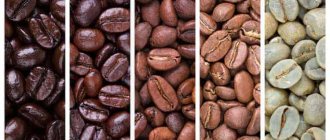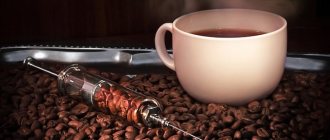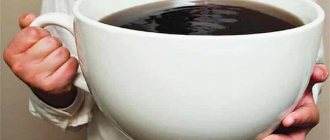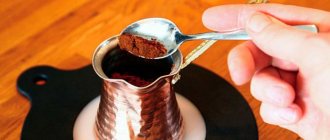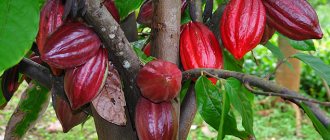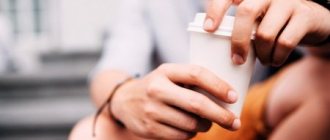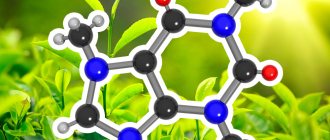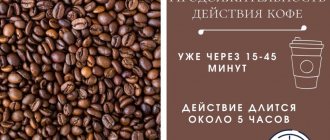What is caffeine?
Caffeine is a substance that is found naturally in the leaves and seeds of many plants.
Man also learned to create an artificial analogue, the formula of which is C8H10N4O2, and use it in food. Caffeine has medicinal properties and is used as a stimulant of the central nervous system, causing increased activity. Most people respond to this substance with increased energy and improved mood.
Caffeine is found in tea, coffee, chocolate, various soft drinks, and is also part of painkillers. Natural caffeine has a bitter taste, but in many products this bitterness is masked by processing.
Content:
- What is caffeine?
- Metabolism
- Effect on the body
- Caffeine overdose
- How does it get into the blood?
- Caffeine and pregnancy
- Effect on the stomach
- Side effects
- Harmful properties
- Effects of quitting caffeine
- How to safely quit caffeine
- Benefit for health
- Invigorating springs
The main sources of this substance for teenagers are energy drinks and other soft drinks. Their “work” is noticeable, as a rule, for 6 hours. True, sensitivity to caffeine is an individual indicator. Typically, the younger the person, the less of the substance is needed to feel its effects. Individuals who regularly consume caffeinated beverages become less sensitive to this energizing component over time. This means that they will need to increase the dose again and again to achieve the effect.
The culture of drinking coffee and other caffeinated drinks
There are safe doses of caffeine. In our country it is 300 mg per day. In the European Union countries, a dose of 400 mg is accepted as safe. It should be borne in mind that different types of coffee or tea have different concentrations of caffeine, so it is impossible to calculate a safe dose in cups. Death occurs when taking 10 to 20 g of caffeine. For a person weighing 70 kg, this amount of alkaloid is contained in approximately 100 cups of coffee.
It is not recommended to mix caffeinated drinks with alcohol and medications. The alkaloid reduces the effect of taking certain medications, and in some cases enhances it, which is also unfavorable. Therefore, taking tablets with coffee or tea is a bad idea.
Caffeine abuse
Intoxication from an overdose of caffeine is expressed by rapid heartbeat, dizziness, nausea, vomiting, headache, and a drop in blood pressure.
Caffeine addiction is very rare. Most often, this phenomenon is observed in places of deprivation of liberty, where chifir is traditionally drunk. Caffeine is the only psychoactive substance available to prisoners. With caffeine addiction, severe somatic disorders develop. Thanks to them, addiction to caffeine and caffeine-containing products can disappear on its own. In case of severe caffeine overdose, emergency measures are required. The first step is to induce vomiting, and then call an ambulance. The doctor will be able to monitor the activity of the cardiovascular system and prescribe symptomatic treatment.
Metabolism
Once in the body, caffeine is metabolized into dimethylxanthine derivatives (paraxanthine, theobromine, theophylline), then into monoxanthine, and then into the xanthine molecule. Other metabolic products are di- and trimethyl allantoin, uric acid and uracil derivatives.
Caffeine is easily distributed in plasma, intercellular fluid and inside cells. It also circulates in extracellular adipose tissue. By the way, people who smoke metabolize caffeine faster. Also, differences in the speed of the process may occur among people of different nationalities, which is explained by a genetic factor. But there is practically no difference in the rate of absorption between women and men.
Our body is able to absorb these “energizing molecules” quite quickly. But it also quickly gets rid of them. Caffeine is metabolized primarily by the liver and has a relatively short half-life. Usually 5-7 hours are enough to get rid of half of the resulting substance. For this reason, the cup of coffee you enjoyed before lunch will definitely not prevent you from falling asleep in the evening.
Caffeine can be synthetic or natural (obtained from plants). It is possible to determine the difference between them only in the laboratory. The concentration of any of these substances in the body can be measured by examining saliva, since this substance accumulates primarily in liquids in the body. Caffeine can enter the body through the mucous membranes of the cheeks. Chewing gum containing the substance is characterized by faster absorption compared to drinking coffee, since in the form of a drink, caffeine must first pass through the stomach and intestines, and only then enters the blood.
The role of caffeine in the human body
Caffeine is a well-known naturally occurring stimulant. It enhances excitation processes in the cerebral cortex and increases motor activity (more information in the article caffeine).
When consumed in moderation, the alkaloid has beneficial properties:
- helps to cheer up and overcome drowsiness;
- improves mood;
- reduces the risk of blood clots;
- prevents the occurrence of strokes and heart attacks;
- helps get rid of vascular spasm and headaches;
- promotes weight loss;
- protects against the risk of developing diabetes;
- increases activity and improves metabolism.
Read useful: How does phosphatidylserine help improve brain function?
Effect on the body
Caffeine is a product of plant origin, the highest concentration of which is found in coffee beans, tea leaves, soft drinks, chocolate, and cocoa beans.
Also found in some medications (painkillers, allergies, colds and weight loss). In fact, from a chemical point of view, caffeine is a pain reliever and also a substance that enhances the effects of other pain-relieving drugs.
Modern data on caffeine is very contradictory regarding its beneficial and negative effects on the human body.
It is believed that for healthy people, 300 mg of an invigorating substance per day is a normal portion that is not harmful to health. Meanwhile, in some cases it is important to limit the consumption of the substance. Large portions (more than 700 mg per day) help remove calcium and magnesium from the body. It was previously believed that caffeine was one of the causes of osteoporosis. Meanwhile, recent studies have shown that calcium losses caused by caffeine from 1 cup of coffee can be easily compensated for by 2 tablespoons of milk. But in people who are especially sensitive to even minor calcium losses, caffeine can actually cause bone problems. For this reason, women after menopause should not abuse caffeine-containing products, since they are already at risk of developing osteoporosis.
It also acts on the body as a mild diuretic. But again, don't worry that foods containing this substance can cause dehydration.
When talking about caffeine, many people think of coffee first. But this is far from the only source of the substance. Tea, cola and other drinks also contain caffeine. And this explains why, according to research, children aged 6-9 years consume approximately 25 mg of the energizing substance daily, and their parents may not even realize it. Meanwhile, children sensitive to it develop irritability and anxiety.
Caffeine acts as a stimulant, affecting the central nervous system. In the body, this substance begins to act approximately 15 minutes after administration and this effect lasts up to 6 hours.
Who should remove foods that contain the most caffeine from their menu?
Caffeine is a natural alkaloid with a mild narcotic effect. There are many studies that talk about both the benefits and harm. In fact, its properties of imparting energy and stimulating performance became known back in the 4th century BC. And green tea, which contains no less caffeine, has been drunk in China for thousands of years. These days, products containing this invigorating substance are also extremely popular. And doctors never cease to argue about the norms and contraindications of caffeine consumption.
There is no clearly defined norm of use. The human body does not need to supply this substance. Therefore, it is possible to remove this substance from the diet without the slightest harm to health. Because if in small doses a psychostimulant has a stimulating effect on the human nervous system, then in large quantities it causes exhaustion. The maximum dose is 150-200 mg per kilogram of human weight. However, consuming such an amount is extremely difficult and would require approximately 90 cups of coffee in a short period of time. This dose is lethal for humans.
Anxiety disorder caused by caffeine overdose
It is undesirable for people with high levels of anxiety to abuse caffeinated drinks. Individuals who are prone to nervousness and anxiety in normal situations may exacerbate these qualities with the help of caffeine. People suffering from insomnia often become dependent on invigorating drinks. It is better for them not to drink coffee before bed, and to reduce it during the day. People with hypertension should also control their caffeine intake, as it can quickly increase blood pressure.
People should avoid caffeine consumption:
- with gastrointestinal diseases (gastritis, ulcers, pancreatitis and others);
- those suffering from dysbacteriosis;
- in case of poisoning, bloating;
- diseases of the cardiovascular system;
- with atherosclerosis of cerebral vessels;
- with varicose veins;
- with anemia;
- for mastopathy;
- with uterine fibroids;
- with hyperthyroidism;
- with MSCH, cystitis, pyelonephritis;
- with candidiasis;
- with manifestations of allergies, psoriasis;
- with liver diseases (cirrhosis, hepatitis C, fatty liver);
- gout.
In addition, it is recommended to limit caffeine intake to 200 mg:
- pregnant and lactating women;
- persons planning pregnancy.
It is safe for children and adolescents to consume:
- at the age of 4 to 6 years 45 mg per day;
- from 7 to 9 years 62.5 mg per day;
- from 10 to 12 years 85 mg per day.
Adults are not recommended to exceed a dose of 400 mg per day. People with cardiovascular disease should be careful when consuming caffeine. It has been proven to increase blood pressure for 3-4 hours. However, with regular and moderate use, this effect is not so noticeable. But it’s better to discuss acceptable doses with your doctor.
Medical experts advise against drinking instant coffee, especially if people have health problems. Natural varieties must be softened when consumed. This can be done by adding milk to the drink, choosing a variety with a reduced caffeine content, reducing the preparation time of the drink, and preferring varieties with lightly roasted beans.
Reduced caffeine coffee is delicious
Caffeine overdose
Consuming moderate doses (up to 250 mg of brewed coffee or 500 mg of cola) helps people concentrate and relieve drowsiness. But higher doses increase heart rate, raise body temperature, increase blood flow to the skin and extremities, increase blood pressure and blood sugar levels, and also stimulate the secretion of stomach acid, acting as a diuretic.
With excessive consumption of the substance, people may experience dizziness, hypoglycemia, nausea, rapid breathing and heart rate, confusion, irritability, insomnia, changes in appetite, dry mouth and other side effects. But contrary to popular belief, caffeine cannot neutralize alcohol in the body.
How much caffeine is in desserts?
An increased amount of caffeine in the diet causes drowsiness and exhaustion of the nervous system. Plus, the effect of narcotic and sleeping pills is weakened, since the excitation of the spinal cord increases. Caffeine enhances the work of the heart, contracts the myocardium more often and more intensely, so it is especially contraindicated for hypertensive patients. It should be understood that even if a person excludes tea and coffee from the diet, this does not mean eliminating caffeine. This alkaloid is found in many foods. Wherever there is chocolate, there is also caffeine. Therefore, if there is a goal to eliminate caffeine, then it is necessary to carefully review the menu and analyze food products. Below is a table of products that contain the alkaloid and how much:
| Product name | Quantity (grams) | Caffeine content (mg) |
| bitter chocolate | 100 | 90 |
| Milk chocolate | 100 | 15 |
| Cocoa powder | 100 | 230 |
| Chocolate ice-cream | 100 | 36 |
| Coffee ice cream | 100 | 50 |
Chocolate
Chocolate understands mood and relieves depression precisely thanks to the action of the alkaloid. Dark chocolate contains 90 mg of caffeine per 100 grams. Due to the reduced amount of cocoa, milk contains only 15 mg for the same weight. White chocolate has no caffeine because there is no cocoa powder.
Cocoa powder
Per cup of the finished drink, there is about 8-12 mg of caffeine. However, in the powder itself the concentration is much higher, up to 230 mg per 100 grams of ground cocoa beans.
Ice cream
Since there is chocolate in ice cream, there is also caffeine. Per 100 grams of product there is about 36 mg of alkaloid. The same situation applies to coffee ice cream. Of course, the information is relevant, provided that the composition contains coffee and not an artificial flavor. 100 grams of product contains up to 50 mg of caffeine.
How does it get into the blood?
Once in the body, caffeine is absorbed in the intestines by almost 99%. And the concentration of the substance in the body can reach up to 10 mg per 1 kg of weight. The entire absorption process occurs within approximately 45 minutes after ingestion, and caffeine reaches its peak level in the blood within 15-20 minutes. But these are rough estimates, since in each case the rate of absorption of substances depends on physiology and the source. Caffeine is absorbed slowest from chocolate and cola, while caffeine from coffee drinks and substances in tablet form is absorbed faster. But still, it is absorbed most quickly from chewing gum - through the mucous membranes of the oral cavity.
How long does caffeine last in the body?
On average, about 5 hours pass from the moment the natural energy drink enters until it completely disintegrates. In the first 20–40 minutes after consuming caffeine, its highest concentration in the body and its strongest effect are observed.
Moreover, the presence of the alkaloid manifests itself differently in each person: some experience an increase in energy, others complain of increased irritability and the urge to urinate frequently. Literally an hour later the symptoms completely disappear.
Side effects
Consuming caffeine in moderate doses generally does not have any harmful side effects on the body. Although some researchers convince that regular consumption of 100 mg of coffee daily can subsequently cause infertility, heartburn and intestinal dysfunction.
Consuming high doses of caffeine deprives you of sleep, and a person stops noticing the body's signals about the need for rest. Meanwhile, it is important to understand that caffeine does not replenish energy reserves or prevent emotional fatigue. It simply blocks the body's physiological needs for rest. Over time, this condition leads to the development of depression, causing anxiety, excessive nervousness, sweating and tremors.
Drip coffee
One cup contains about 165 mg of caffeine. You can add milk to this drink to soften its bitterness.
This drink is prepared using paper filter bags.
, into which ground coffee is poured and filled with water.
Compared to espresso
, drip coffee is dependent on pressure caused by heat and gravity to pull it down. Paper filters retain oils that are usually present in espresso.
The brewing process itself is very simple - it's like making an instant drink! At the same time, you get a cup of natural and aromatic coffee.
Specialists use special utensils to brew this coffee for clients.
How to make coffee using pour over method
Harmful properties
Some studies suggest that caffeine may be harmful to your health. Here are some arguments in favor of this.
- Consuming more than 4 cups of coffee per day leads to early death. Research shows that this dose, taken daily, is enough to increase the risk of sudden death by 21%.
- Increases blood pressure. In people suffering from arterial hypertension, after 2 cups of coffee, blood pressure rises over the next 2-3 hours.
- Increases the risk of cardiac diseases at a young age. Drinking 4 cups of coffee daily is enough to quadruple your risk of heart attack.
- Caffeine can trigger the development of gout.
- Provokes the formation of cysts in the mammary glands in women. It is enough to consume 30 mg of coffee per day to increase the chances of fibrocystic mastopathy by one and a half times. And women who drink 500 mg of coffee are 2-3 times more at risk of cystitis.
- Causes urinary incontinence. People who consume the drink regularly and in large doses are 70% more likely to experience incontinence than others.
- Causes insomnia.
- Causes stomach upset. Especially if you drink coffee on an empty stomach.
- Excessive caffeine consumption provokes headaches.
- Caffeine leads to impaired fertility in women: the chances of getting pregnant are reduced by 27%.
- The risk of miscarriages increases: it is enough to drink 2 servings of coffee daily for several weeks before conception.
- It worsens the health of diabetics because it disrupts glucose metabolism.
- May cause overdose or allergy symptoms.
- Accelerates heart contraction.
- Exacerbates the symptoms of menopause.
- Increases anxiety and depression.
- Caffeine lovers consume more glucose, which is fraught with obesity and diabetes.
- It suppresses collagen production in the skin.
- Makes bone tissue more fragile, which increases the risk of fractures.
How to replace coffee in the morning
There is an alternative to coffee in the morning. Since doctors say that you should not drink this drink in the morning, especially on an empty stomach. You can give preference to tea. Depending on the variety, it will contain about 15-70 mg of caffeine. This way you can get the necessary boost of energy. In addition, you should not ignore cocoa, because in addition to caffeine, it contains theobromine, which invigorates and is not harmful to health. A chocolate bar during breakfast will provide up to 30 mg of caffeine. And mate contains very little alkaloid, but it tones perfectly.
If teas and chocolate do not suit you, then you can give preference to chicory. The root of this useful plant has long been a competitor to coffee beans. It grows throughout Russia, Ukraine and Belarus. Its tonic properties are similar to those of coffee. This drink achieves its stimulating properties thanks to the glycoside intibin, a natural analogue of caffeine. It looks and tastes very much like coffee, but contains a whole list of health benefits. In addition, some claim that roasted and ground date seeds are no worse than aromatic coffee.
In moderation, caffeine is even beneficial, provided there are contraindications due to health conditions. At the same time, it is necessary to avoid energy drinks and carbonated sweet drinks with additives; in addition to the harm from the alkaloid, they cause irreparable harm to the entire body. It's better to eat some chocolate or drink a cup of coffee.
When choosing coffee, it is better to give preference to grain varieties, since in addition to caffeine, they contain a lot of useful substances, unlike instant varieties. In addition, natural coffee is tastier and more aromatic. Instant coffee is rich in various flavors and dyes, which will aggravate the harm from the alkaloid. Instant coffee contains more caffeine than natural coffee.
The benefits of grain varieties outweigh the risk of harm, and the pleasure of a cup of coffee: well, you understand
Coffee connoisseurs will be interested in familiarizing themselves with recipes for making mochaccino, amaretto, mocha and raf coffee. Coffee with cola, marshmallow and fashionable frappuccino will surprise you with their unusual taste. And lovers of the classics will like espresso, Irish and Viennese coffee.
Effects of quitting caffeine
People who stop drinking caffeinated drinks may experience discomfort and deterioration in the first 12-24 hours. Typically, the first side effects of caffeine withdrawal include headaches, irritability, nausea, nervousness, and muscle tension. But these symptoms last no longer than a week. Then the body finally adapts to a new way of life.
In order to avoid side effects, experienced people advise switching to a caffeine-free life gradually - reducing the amount of substance consumed every day.
Table of products containing caffeine
A table with an exact indication of the volume of the substance will help you get an idea of the caffeine content in food.
| The product's name | Serving volume (ml) | Caffeine content (mg) |
| Natural coffe | 220 | 135 |
| Instant coffee | 220 | 95 |
| Dark chocolate | 100 | 40 |
| Cocoa | 220 | 5 |
| Green tea | 220 | 30 |
| Coca Cola | 330 | 34,5 |
We recommend reading: What are the benefits of cocoa, its properties, how to prepare it
The amount of substance in chocolate may vary depending on the percentage of cocoa in the composition. It is present in smaller quantities in milk chocolate products. Its volume in green tea is affected by the duration of brewing the drink. The longer the tea is kept covered, the higher the caffeine content.
When to see a doctor
Long-term consumption of products containing caffeine in excess amounts can be harmful to health. The first alarm bells include epigastric pain and increased nervousness. In this case, you need to consult a doctor for a general examination of the body. If your diet contains a lot of caffeine, the risk of exacerbation of diseases of the digestive system increases.
A visit to the doctor is also necessary if symptoms of acute intoxication appear. To remove the substance from the body, you may need to take medications. Their appointment is carried out by a specialist.
It should be remembered that the alkaloid has the ability to flush calcium and iron from the body. For problems with the musculoskeletal system and iron deficiency anemia, this quality is very critical. There is a risk of the disease getting worse with further complications.
How to safely quit caffeine
Try drinking plain water instead of cola first. Stick to this principle for a week. Have your caffeine cravings decreased? This means that the “treatment” must be continued. Now is the time to replace traditional coffee with a similar decaffeinated drink. It is also important to track portions of food consumption. Continue until your daily caffeine dose drops to 100 mg or less. Gradually giving up caffeine-containing drinks will protect you from unpleasant physiological sensations and will also be less “painful” on a psychological level.
Without caffeine, do you feel tired? Make sure you are getting enough rest per day? Better yet, check the vitamin and mineral balance in the body? Drowsiness and chronic fatigue may indicate vitamin deficiency or other health problems. But caffeine does not cure this.
Macchiato (latte macchiato)
From Italian “latte” is translated as “milk”, so if you say “latte” in a cafe in Italy, they will simply bring you milk, but in order for you to get that same cafe drink, you should say “latte macchiato”.
From Italian “macchiato” translates as “spotted”. This means that you froth warm milk and add a shot of espresso, which means you "leave a coffee stain" on the milk. You can add more espresso if you want to add more bitterness to the milk drink.
Like espresso, this drink contains 75 mg of caffeine. To give the drink even more energy, you can add caramel or vanilla syrup to it, creating a caramel or vanilla macchiato.
Benefit for health
People who regularly consume caffeine (in adequate doses) report improved concentration and cognitive function. For some people it is a remedy for headaches.
According to some data, it can reduce the risk of Parkinson's disease, liver disease, dementia, and type 2 diabetes. But despite the possible positive effects, do not forget that consuming this substance in large doses can have adverse effects.
In addition, caffeine tablets serve as a cure for migraines. Take 1-2 tablets for a week, and then 1 tablet for a month. It also has benefits for bodybuilders, as it helps increase performance by almost 20%. Bodybuilders consume approximately 3 mg of the substance for every kilogram of body weight half an hour before a planned workout.
By the way, depression of the central nervous system, decreased activity (physical and mental), a state close to loss of consciousness, cerebral vascular spasms (migraine), hypotension and asthma can also be reasons to drink a cup of coffee or a tablet containing caffeine. Even infants are also prescribed this substance as a medicine for certain diseases.
Advantages:
- Reduces pain. Two cups of coffee can reduce post-workout pain by 48%.
- Source of fiber. Two cups of brewed coffee provides 1.8 g of fiber.
- Protection against diabetes. Coffee drinkers (1 cup per day) have a 9% lower risk of developing type 2 diabetes.
- Immunity from Alzheimer's. There is an assumption that caffeine can protect against the development of Alzheimer's disease.
- Cure for depression. A 10-year study involving 86 thousand women showed that coffee drinkers were 20% less likely to suffer from depression.
- Protection against Parkinson's. Researchers from Sweden claim that caffeine reduces the chances of developing Parkinson's disease. Incredibly, scientists suggest that this substance can even affect the genetic factor.
- Protection against cardiac diseases. This generally sounds like science fiction, since traditional medicine prohibits people with heart problems from consuming caffeine. But Korean researchers say 3 cups of coffee a day improves health and reduces the chances of heart disease.
- Stronger DNA. The European Journal of Nutrition once reported that the DNA of coffee drinkers is more stable and without damage. They say that this is again due to caffeine.
- Less chance of multiple sclerosis – 4 cups of caffeinated beverage per day can protect against multiple sclerosis, preventing neuronal damage that causes the disease. At least that's what researchers from Sweden think.
- Reduces the risk of cancer. Moderate caffeine consumption reduces the risk of colon cancer by 26%. This was stated by scientists from California after a study involving 5,100 people. And another group of scientists from a cancer center in Southern California noticed that coffee drinkers were 29% less likely to get liver cancer.
- No gout. A study involving more than 50 thousand people allowed scientists to conclude that coffee protects men from gout. It is believed that this is the “work” of caffeine. Although no one can give a 100% guarantee of this yet. Moreover, there is a completely opposite opinion that it is precisely this that causes gout.
In addition, some experiments have shown that caffeine can stimulate sexual desire in women, protect against early death (according to Japanese scientists), prevent tooth decay, retinal damage and even melanoma.
What is the caffeine content in drinks
In fact, there are many drinks that contain caffeine: coffee, black and green tea, cocoa, hot chocolate and others. However, the amount of this substance in coffee cannot be stated immediately, because it depends on the variety. The most concentrated is Robusta. Also, the quantity depends on the preparation time; coffee brewed in a Turkish coffee pot in 3 minutes will not be as strong as in a coffee machine. Let's take a closer look at these indicators:
| Drink name | Volume (ml) | Amount of caffeine (mg) |
| Cocoa | 200 | 8 |
| Energetic drinks | 200 | 64 |
| Coca Cola | 200 | 44 |
| Pepsi cola | 200 | 42 |
| Black tea | 200 | 53 |
| Green tea | 200 | 28 |
| Espresso | 200 | 266 |
| Coffee brewed in Turk | 200 | 128 |
| Instant coffee | 200 | 77 |
| Instant cappuccino | 200 | 16 |
| Mate | 200 | 44 |
| Decaffeinated coffee | 200 | 3 |
| Hot chocolate | 200 | 25 |
| Iced tea (bottle) | 200 | 29 |
| Nonalcoholic beer | 200 | 12 |
Cocoa
You get about 8 mg of caffeine per cup. However, the cocoa bean powder drink contains theobromine. Its properties are almost identical to caffeine, but there are no such harmful effects. Proper preparation practically neutralizes the alkaloid in the drink, but as a result the person receives a boost of energy.
Energetic drinks
Caffeine is always present among the components of such drinks. Its quantity may vary, it all depends on the manufacturer. Some companies prefer to prescribe false ingredients, but you should not believe this. All energy drinks contain caffeine in amounts ranging from 64 mg per serving. At the same time, it is quickly absorbed into the blood and gives vigor. However, this puts a lot of stress on the cardiovascular system, so you shouldn’t get carried away with them.
Coca-Cola and Pepsi
Carbonated drinks with caffeine and taurine can contain up to 42-44 mg per glass. Their action is designed to stop the release of a hormone that signals the brain to rest. Plus, a large amount of sugar gives energy. But you need to understand that frequent use of such a cocktail can seriously harm your health.
Black and green tea
Varieties of tea depend on the processing of the leaves. Long fermentation produces black tea, which increases the amount of caffeine due to oxidation. It should be noted that antioxidant qualities do not depend on the type of tea. But if you need to cheer up, then it is better to choose black varieties.
Coffee
Of course, coffee is the richest caffeine drink. It is generally accepted that coffee is more harmful than tea. But if we talk about a healthy person, then it is incorrect to compare these two drinks. They are different in action and meet different needs. Yes, and they should be used differently. Coffee in small cups, teas are more everyday drinks. One cup of freshly prepared coffee contains from 100 to 210 mg of this substance. Robusta is the richest variety; even Arabica contains several times less alkaloid. To prevent possible harm, you should give preference to grain coffee and not abuse the drink. Three cups during the day are enough to give you energy.
Mate
Paraguayan herbal tea has an excellent tonic effect. And also contains caffeine. In low concentration, similar to cocoa.
Hot chocolate
Natural hot chocolate contains from 25 mg of caffeine per serving. Any product containing cocoa beans contains caffeine. Even a glass of chocolate milk contains approximately 5 mg of the alkaloid.
I will not write about the benefits and harms of caffeine, its effect on the body, caffeine content in other products, comparison with tea and chocolate. I suppose if you are interested in the amount of caffeine in coffee, then you are already aware of all this. We will only talk about coffee drinks. I’ll just write that on average, a daily dose of 300-500 mg is considered safe for a healthy person, and approximately 200 mg per 1 kg of body weight (15,000 mg for a person weighing 75 kg), taken over several hours, is a lethal dose.
I have a profile on decaffeinated coffee. Measuring the exact caffeine content requires a laboratory with the proper equipment, so I will rely on research from other people and organizations, as well as data from the beverage manufacturers themselves, which I consider the most reliable source.
How much caffeine is in a cup of coffee?
There can be no adequate answer to such a question at all. It is necessary to clarify what kind of cup of coffee we are talking about, first of all, how the coffee was prepared and how much of it, coffee, is in the cup in milliliters or grams. There are other factors, but these are the main ones.
It follows that you can’t say things like “espresso has the most caffeine, so it’s safer to drink an Americano or filter coffee” - this is complete nonsense. Specifically, in this example, a classic Americano contains exactly the same amount of caffeine (because it is the same shot of espresso diluted with hot water), and on average, one serving of filter coffee contains more caffeine than one serving of espresso. You need to compare specific portions of specific coffee drinks.
For those who do not want to read the entire article, the table
| McDonalds | Starbucks | Typical Arabica | Typical Robusta | Nespresso capsules | Decaffeinated coffee (decaf) | |
| Turka 200 ml | — | — | 130-170 mg | 260-340 mg | — | 2-3 mg |
| Espresso 30-40 ml | 71 mg | 75 mg | 40-60 mg | 80-120 mg | 50-100 mg | 1 mg |
| Double espresso 60 ml | 142 mg | 150 mg | 80-120 mg | 160-240 mg | — | 2 mg |
| Americano 240 ml/360 ml | 71/142 mg | 75/150 mg | 40-120 mg depending on single or double espresso | 80-240 mg depending on single or double espresso | — | 1-2 mg |
| Cappuccino 240 ml/480 ml | 71/142 mg | 75/150 mg | 40-120 mg depending on single or double espresso | 80-240 mg depending on single or double espresso | 50-100 mg | 1-2 mg |
| Latte 360 ml/480 ml | 71/142 mg | 75/150 mg | 40-120 mg depending on single or double espresso | 80-240 mg depending on single or double espresso | 50-100 mg | 1-2 mg |
| Filter coffee (for those who don’t understand, it’s just “coffee”) 360 ml/480 ml | 109/145 mg | 235/310 mg | 100-200 mg depending on volume (linear relationship), beans and pouring method | 200-400 mg depending on volume (linear relationship), beans and pouring method | — | 2-3 mg |
| Aeropress 180 ml | — | — | 80-120 mg | 150-200 mg | — | 1-2 mg |
| French press 200 ml | — | — | 120-150 mg | 240-300 mg | — | 2-3 mg |
- Data from McDonalds, Starbucks, Nespresso and Nescafe are from the manufacturers themselves for the US market, because they are required to publish them there, but we do not. But as a guide, this table is very indicative; plus/minus such average values in drinks by type and similar volumes will be in the Russian Federation and in other countries, as well as for other manufacturers/coffee shops. Data on Nespresso capsules are given for Nespresso Original (regular capsules), the new Nespresso Vertuo has a higher caffeine content.
About caffeine in espresso and drinks based on it
A double espresso is typically made from approximately twice the amount of ground coffee. This is if it's rude. In most modern coffee shops, the typical amount of ground coffee for single and double espresso is 10/18 grams, but there are, for example, 12/20 grams.
Americano, cappuccino, and latte are made in normal coffee shops from single espresso. In establishments like McDuck, for large portions (300+ ml) a double tab is used. Flat White and Long Black are always made from double espresso. Neither water nor milk has any effect on the caffeine content in the finished drink, that is, in the cup.
These are general principles for all these drinks, regardless of whether it is McDuck, Starbucks or the coffee-to-go stand at the bus stop. Or you brew yourself at home in an automatic Delongie - all milk and Americano, with the exception of some cunning special programs, are made from ordinary espresso and there is the same amount of caffeine.
Example of a special program: Flat White from Jura uses a double layer of ground coffee, which at maximum strength will be 2x16=32 grams.
About caffeine in filter coffee and alternatives
Notice in the table that a single shot of filter coffee contains significantly more caffeine than a single shot of espresso? The exact amount can vary greatly depending on the type of coffee and brew settings, but the pattern remains the same. Moreover, filter coffee is understood equally as a funnel/pour over/drip coffee maker/Chemex/Hario - the preparation principle is the same, therefore, the values per unit volume are approximately the same.
About caffeine in Turk/Cezve
I have not found a single reliable source measuring caffeine in a serving of Oriental coffee. But from general considerations about extraction and the physics of the process, there should be a little more of it in one 100 ml serving than in a single 30 ml espresso. Accordingly, 200 ml of Turkish coffee contains a double dose of caffeine, and it is more than a double espresso. When calculated per serving, not liters or milliliters, this is the most caffeinated drink.
About caffeine in instant coffee
Instant coffee contains almost no natural caffeine. It is seriously destroyed by soaking and heating, the final drying of the concentrate from the original ground grains from which the solution is made. Yes, instant coffee is still made from real coffee beans. All instant coffee manufacturers add synthetic caffeine (made from uric acid and xanthine) to the product to varying degrees. How much they add, little or much, is their business. I repeat that in some countries manufacturers are required to write the caffeine content on the packaging, but here we do not.
For example, instant Nescafe Classic contains 98 mg and 130 mg of caffeine per 360 and 480 ml cup, respectively (official data from Nestlé). On average, two teaspoons of regular instant coffee contain approximately the same amount of caffeine as a double espresso; one teaspoon contains 30-50 mg, depending on the manufacturer. Despite the fact that some of it is synthetic, this does not change the essence, the main thing is the quantity.
Comparison of drinks by absolute amount of caffeine per serving
In total, if we use the same beans (let it be a typical Brazil Santos) and more or less classic preparation recipes and final volumes, then in terms of 1 serving of the drink, the absolute amount of caffeine in them will be increasing:
What determines the caffeine content for the same brewing method, and how can it be reduced?
Yes, why are there such large ranges of values in the table, sometimes one and a half, or even two times? How to cook closer to the lower limit? Akhtung: boring theory.
The caffeine content of a cup depends mainly on five factors:
- The original amount of caffeine in the original bean.
- The number of beans (in grams, but ultimately in pieces) used to prepare the drink.
- The degree of extraction of chemical elements from grains into the drink. Extraction = extraction.
- The time of preparation, or rather the contact of coffee with water, which affects the percentage of caffeine that will have time to transfer from the beans to the drink, plus it comes out unevenly throughout the entire process.
- The amount of water that comes into contact with the coffee.
1. Grains
Robusta has about twice as much caffeine as Arabica. The taller the coffee tree grew, the less caffeine it likely contained in its beans. This is not a 100% rule, but it is usually true. Washed processed beans usually contain less caffeine than naturally processed or experimentally processed beans (for information on processing, see the profile on machine coffee). When preparing the same drink from different beans in the same way, the more sour the result tastes, the less caffeine it is likely to contain.
In summary, the first principle of reducing caffeine in a cup is to use high-altitude washed Arabica beans from countries such as Ethiopia, Kenya, Tanzania, Colombia. Counter-examples: robusta from Uganda, Vietnam, India.
According to the latest data, roasting does not directly affect the caffeine content in each bean; the amount of caffeine that was in the original green bean remains the same during any roasting. But the more the grain is roasted, the more it loses in mass. And 10 grams of light-roasted grain, if counted in pieces, will contain fewer grains than 10 grams of dark-roasted grain. And since each bean contains the same amount of caffeine, it means that 10 grams of a light-roasted pile of beans will contain less caffeine than 10 grams of a dark-roasted pile.
The second principle for reducing caffeine in your cup when brewing by weight is to use light roast coffee.
2. Amount of coffee
Obviously, the more beans involved in the preparation of the drink, the more caffeine there will be in the cup. Different drinks are prepared from different amounts of grains. But the same type of drink can also be prepared from different masses, or rather quantities, of grains. In principle, double espresso can be made from 15 grams, or from 20 grams. The difference in this case will be linear; in the second case, there will be a third more caffeine. And the same thing works for plus/minus for all drinks.
There are related nuances when, for example, you doubled the amount of coffee, but reduced the amount of water when preparing the French press, and the water simply couldn’t/didn’t have time to pick up twice as much caffeine because the extraction worsened.
3. Extraction rate
Simply put, it is the extraction of substances from something, in this case from coffee into a drink. Extraction depends on a lot of factors. For example, from source water. Depending on its TDS (total dissolved solids), water may accept more or less substances from coffee, including caffeine. If you're cooking with water from a 100-year-old rusty tap, it won't be able to take much out of the beans, including caffeine. The distillate extracts everything. Of the more tangible, extraction is influenced by the degree of grinding, pressure and temperature. The finer the grind and the higher the rest, the higher the extraction.
Therefore, the greatest extraction per unit of time occurs when preparing espresso, there is both pressure and temperature. But both can be adjusted depending on the equipment. The temperature is regulated even on home grain machines. It’s more difficult with pressure, but on professional carob machines, as well as, for example, on lever coffee makers, you can play with this.
Another question is, what is more important to you: taste or caffeine content? I think it's taste. Therefore, deliberately lowering the amount of coffee used, temperature and pressure in order to reduce milligrams of caffeine, but at the same time drinking under-extracted medicinal herbal swill is just that.
Regarding grinding. Despite the obvious possibility of adjustment, adjusting it to reduce caffeine will not work much. Because for almost every cooking method there is not a very large fork of acceptable grinding. The best illustration is espresso on single-bottom baskets. There, if you almost got into the grinding, then the recipe immediately “went right”, it turned out to be some kind of swill. But this comes back to the question of what is more important to whom.
4. Time
This is an extraction related parameter. The longer coffee is in contact with water of any temperature, the more substances come from it into the drink. Caffeine is no exception. Therefore, Turkish coffee contains a lot of caffeine - the temperature is high, the preparation time is long, and the grinding is minimal. In general, the faster the same type of drink is prepared, the less caffeine it contains. Plus, regarding espresso, there are different versions, but the dominant one is this: caffeine during the preparation process is extracted in the last stages, so interrupting the process a little earlier will result in less caffeine in the cup. For filter coffee and other “long” preparation methods, the question of the order of extraction of substances is no longer so acute; there, everything has time to be extracted from the beans approximately evenly.
5. Amount of water in contact with coffee
It seems that this is directly related to the amount of the final drink per serving? Not always. For example, an Americano, you can pour 100 ml of water into a shot of espresso, or 400 ml, the final volume of the drink in the cup will differ significantly, but the amount of caffeine will be the same. The volume of water that came into contact with the coffee during the brewing process is important. Therefore, large lungos, bulk Turks, filter coffee and similar drinks can contain a lot of caffeine. The lack of pressure during extraction is compensated by the amount of water and the time of its contact with coffee - it manages to take away all the caffeine from the bookmark that, in principle, could have been there initially.
Summary of Caffeine in Coffee
- The smaller the initial coffee content, the amount of water in contact with it, the contact time, temperature and pressure, the coarser the grind, and the higher the altitude and acidic initial grain (and of course without Robusta impurities) - the less caffeine in the final drink.
- This may surprise many, but the least caffeinated drink per serving is ristretto.
- The highest caffeine content is in large portions of Turkish and French press.
- Instant coffee also contains caffeine, each teaspoon contains about the same amount as a single espresso.
If you have contraindications or concerns about caffeine, drink freshly roasted decaf, it can be quite acceptable and even tasty. In this case, a good strategy: drink one serving of any drink made from “normal” coffee in the morning, and then at least drink decaf - the typical caffeine content in a serving of any decaf drink is 1-3 mg.
Bonus track: caffeine in green coffee
Green coffee is beans that have not undergone heat treatment. According to recent studies, roasting beans does not affect the caffeine content in them. That is, one green bean contains as much caffeine as one roasted bean. Since green beans are much heavier than roasted beans, there is less caffeine in green beans per weight. But the main thing is that this caffeine can get into the drink (brewed from green grains) only through extraction - extracting substances from the grain into water.
The extraction for green grain is extremely small, it is simply negligible.
In fact, this is why drinking green coffee infusion is basically useless. If the green grain is whole, then in order to extract at least something from it, it will need to be soaked for a day. If you buy already crushed green beans (grinding them on a regular coffee grinder will not work - they are too hard), then some traces of caffeine will be released into the drink, but this is all from the evil one. For simplicity, you can assume that a drink made from green coffee has the same amount of caffeine as when brewed from decaf. Publication date: 01/07/2022.
Your opinion is important to me. Please rate the material: (Total ratings: 14. Average: 4.79 )
Rating of coffee by amount of caffeine
Another parameter on which the alkaloid content depends is the location of the coffee plantation. Breeders have learned to grow raw materials in such a way as to obtain new tastes and change the strength.
Grains with a high alkaloid content are collected in South America, Colombia and Brazil, but drinks made from them have a mild taste. Products supplied from Africa and the Middle East have a sharp bitter taste.
Robusta
In their pure form, grains of this variety are rarely used - a pronounced bitterness appears in the drink. But lovers appreciate it for its strength, rich taste and density. Caffeine content is up to 4%, that is, for 200 ml of coffee - 380-400 mg.
Monsoon Malabar
One of the types of Arabica, grown in Israel, Egypt, Turkey and Greece. Gives drinks fruity notes with a slight sourness. The variety appeared by chance - during transportation, the grains became moistened, dried out, and changed color. Now the properties are changed at coffee factories in a special installation. A 200 ml cup contains 280 mg of caffeine.
Sulawesi Thoraya
These are freshly roasted beans, artificially aged, with a rich fruity aroma. The raw materials are grown in Indonesia. Per 200 ml - up to 230 g of invigorating alkaloid.


